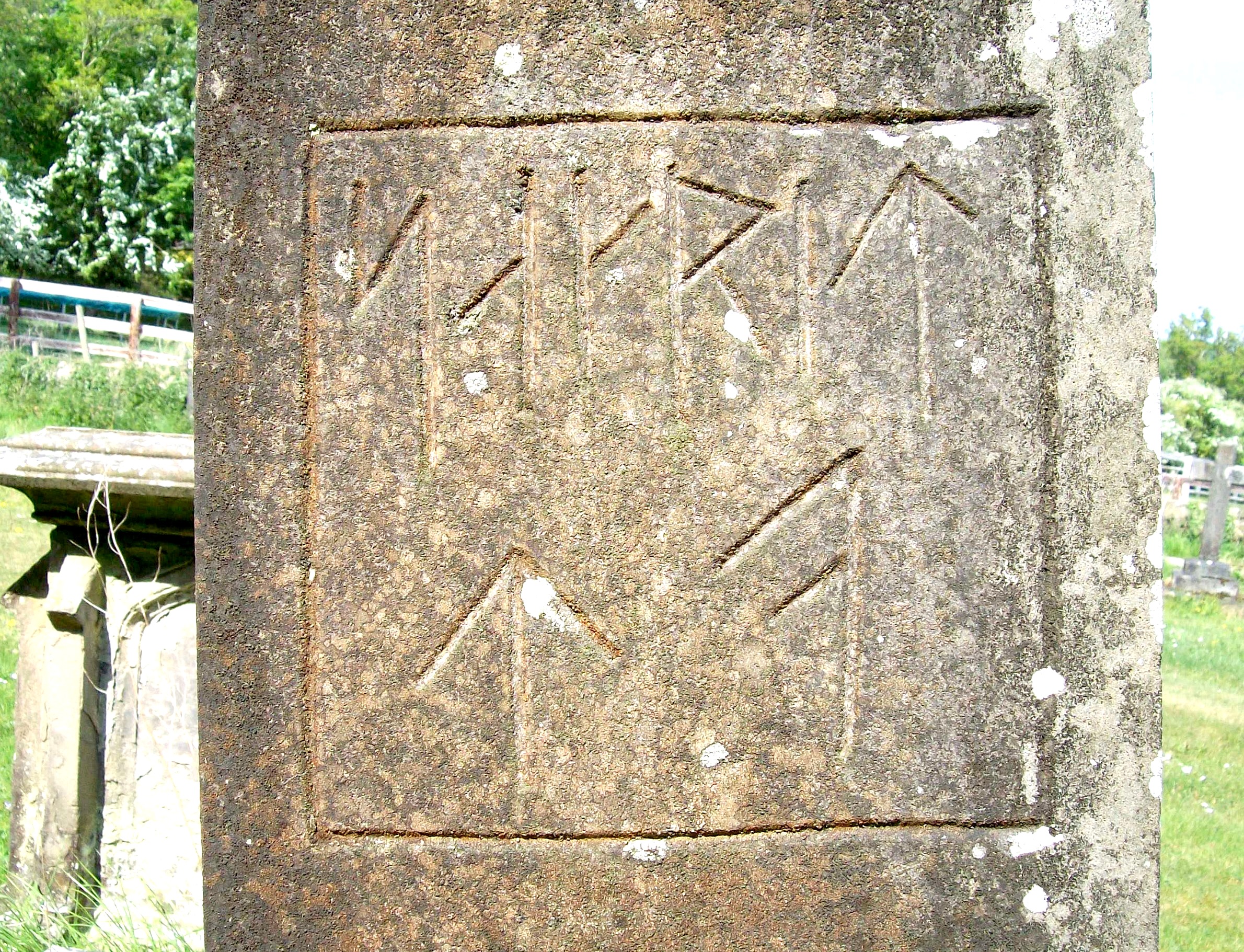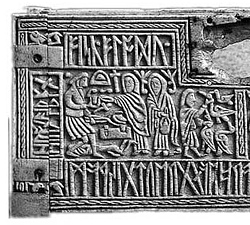|
Modern Runic Writing
Runic alphabets have seen numerous uses since the 18th-century Viking revival, in Scandinavian Romantic nationalism (Gothicismus) and Germanic occultism in the 19th century, and in the context of the Fantasy genre and of Germanic Neopaganism in the 20th century. Early modern period and Viking Revival The use of medieval runes mostly disappears in the course of the 14th century. An exception are the Dalecarlian runes, which survived, heavily influenced by the Latin alphabet, into the 19th century. Occasional use of runes also seems to have persisted elsewhere, as evidenced by the 16th-century Faroe Islands, Faroer Fámjin stone. Antiquarian interest in runes first arises in the 16th century, with the 1555 ''Historia de gentibus septentrionalibus'' by Olaus Magnus, and picks up in the 17th century, notably with Peder Resen's ''Edda Islandorum'' of 1665. In the 17th century, runology pioneer Johannes Bureus published his ''Runa ABC'', the first Swedish alphabet book. Runic cale ... [...More Info...] [...Related Items...] OR: [Wikipedia] [Google] [Baidu] |
Runic Alphabets
Runes are the Letter (alphabet), letters in a set of related alphabets, known as runic rows, runic alphabets or futharks (also, see ''#Futharks, futhark'' vs ''#Runic alphabets, runic alphabet''), native to the Germanic peoples. Runes were primarily used to represent a sound value (a phoneme) but they were also used to represent the concepts after which they are named (ideographic runes). Runology is the academic study of the runic alphabets, runic inscriptions, runestones, and their history. Runology forms a specialised branch of Germanic philology. The earliest secure runic inscriptions date from at latest AD 150, with a possible earlier inscription dating to AD 50 and Tacitus's possible description of rune use from around AD 98. The Svingerud Runestone dates from between AD 1 and 250. Runes were generally replaced by the Latin alphabet as the cultures that had used runes underwent Christianisation, by approximately AD 700 in central Europe and 1100 in northern Europe. Ho ... [...More Info...] [...Related Items...] OR: [Wikipedia] [Google] [Baidu] |
Runic Calendar
A Runic calendar (also Rune staff or Runic almanac) is a perpetual calendar, variants of which were used in Northern Europe until the 19th century. A typical runic calendar consisted of several horizontal lines of symbols, one above the other. Special days like solstices, equinoxes, and celebrations (including Christian holidays and feasts) were marked with additional lines of symbols. Runic calendars were written on parchment Parchment is a writing material made from specially prepared Tanning (leather), untanned skins of animals—primarily sheep, calves and goats. It has been used as a writing medium in West Asia and Europe for more than two millennia. By AD 400 ... or carved onto staves of wood, bone, or horn. The oldest one known, and the only one from the Middle Ages, is a staff from Nyköping, Sweden, believed to date from the 13th century. Most of the several thousand which survive are wooden calendars dating from the 16th and the 17th centur ... [...More Info...] [...Related Items...] OR: [Wikipedia] [Google] [Baidu] |
Hagal (Armanen Rune)
Hagal is the 7th pseudo-rune of Armanen Futharkh of Guido von List Guido Karl Anton List (5 October 1848 – 17 May 1919), better known as Guido von List, was an Austrian occultist, journalist, playwright, and novelist. He expounded a modern Pagan new religious movement known as Wotanism, which he claimed w ..., derived from the Younger Futhark ''Haglaz, Hagal'' rune . Hagal is the "mother rune" of the Armanen system and also seen as such by List's contemporaries Jörg Lanz von Liebenfels, Adolf Schleipfer, Peryt Shou, Siegfried Adolf Kummer, Rudolf John Gorsleben, Friedrich Bernhard Marby, Werner von Bülow, Wilhelm Wulff and more recently Karl Spiesberger and Karl Hans Welz. It is seen as the central axis point of the Hexagonal crystal system, hexagonal crystal of which the Armanen runes are derived. In one of its simple formats, it resembles the Wendehorn. See also *Armanen runes *Julleuchter Notes {{reflist References * von List, Guido - Das Geheimnis der ... [...More Info...] [...Related Items...] OR: [Wikipedia] [Google] [Baidu] |
Futhorc
Anglo-Saxon runes or Anglo-Frisian runes are runes that were used by the Anglo-Saxons and Medieval Frisians (collectively called Anglo-Frisians) as an alphabet in their native writing system, recording both Old English and Old Frisian (, ᚱᚢᚾᚪ, "rune"). Today, the characters are known collectively as the futhorc (ᚠᚢᚦᚩᚱᚳ, ''fuþorc'') from the sound values of the first six runes. The futhorc was a development from the older co-Germanic 24-character runic alphabet, known today as Elder Futhark, expanding to 28 characters in its older form and up to 34 characters in its younger form. In contemporary Scandinavia, the Elder Futhark developed into a shorter 16-character alphabet, today simply called Younger Futhark. Use of the Anglo-Frisian runes is likely to have started in the 5th century onward and they continued to see use into the High Middle Ages. They were later accompanied and eventually overtaken by the Old English Latin alphabet introduced to Anglo-Sax ... [...More Info...] [...Related Items...] OR: [Wikipedia] [Google] [Baidu] |
Armanen Runes
Armanen runes (or ''Armanen Futharkh'') are 18 pseudo-runes, inspired by the historic Younger Futhark runes, invented by Austrian mysticist and Germanic revivalist Guido von List during a state of temporary blindness in 1902, and described in his ''Das Geheimnis der Runen'' ("The Secret of the Runes"), published as a periodical article in 1906, and as a standalone publication in 1908. The name seeks to associate the runes with the postulated Armanen, whom von List saw as ancient Aryan priest-kings. The runes continue in use today in esotericism and in Germanic neopaganism. Publication Von List claimed the pseudo-runes were revealed to him while in an 11-month state of temporary blindness after a cataract operation on both eyes in 1902. This vision in 1902 allegedly opened what List referred to as his "inner eye", via which the "Secret of the Runes" was revealed to him. List stated that his Armanen Futharkh were encrypted in the ''Rúnatal'' of the Poetic Edda (stanzas 138 to ... [...More Info...] [...Related Items...] OR: [Wikipedia] [Google] [Baidu] |
Guido Von List
Guido Karl Anton List (5 October 1848 – 17 May 1919), better known as Guido von List, was an Austrian occultist, journalist, playwright, and novelist. He expounded a modern Pagan new religious movement known as Wotanism, which he claimed was the revival of the religion of the ancient German race, and which included an inner set of Ariosophical teachings that he termed Armanism. Born to a wealthy middle-class family in Vienna, List claimed that he abandoned his family's Roman Catholic faith in childhood, instead devoting himself to the pre-Christian god Wotan. Spending much time in the Austrian countryside, he engaged in rowing, hiking, and sketching the landscape. From 1877 he began a career as a journalist, primarily authoring articles on the Austrian countryside for nationalist newspapers and magazines. In these he placed a '' völkisch'' emphasis on the folk culture and customs of rural people, believing that many of them were survivals of pre-Christian, pagan religio ... [...More Info...] [...Related Items...] OR: [Wikipedia] [Google] [Baidu] |
Austria
Austria, formally the Republic of Austria, is a landlocked country in Central Europe, lying in the Eastern Alps. It is a federation of nine Federal states of Austria, states, of which the capital Vienna is the List of largest cities in Austria, most populous city and state. Austria is bordered by Germany to the northwest, the Czech Republic to the north, Slovakia to the northeast, Hungary to the east, Slovenia and Italy to the south, and Switzerland and Liechtenstein to the west. The country occupies an area of and has Austrians, a population of around 9 million. The area of today's Austria has been inhabited since at least the Paleolithic, Paleolithic period. Around 400 BC, it was inhabited by the Celts and then annexed by the Roman Empire, Romans in the late 1st century BC. Christianization in the region began in the 4th and 5th centuries, during the late Western Roman Empire, Roman period, followed by the arrival of numerous Germanic tribes during the Migration Period. A ... [...More Info...] [...Related Items...] OR: [Wikipedia] [Google] [Baidu] |
Esotericism In Germany And Austria
Germany and Austria have spawned many movements and practices in Western esotericism, including Rosicrucianism, Theosophy, Anthroposophy and Ariosophy, among others. Early Esotericism Knights Templar and Freemasonry The original Knights Templar, founded around 1119, had been a crusading military order, that, at some time, had established financial networks across the whole of Christendom. In 1307, King Philip IV of France mounted a "slanderous campaign" to strip the Order of its economic and political influence. The Templars were accused of Satanic practices, perversions and blasphemy and ruthlessly suppressed; Its leaders were burned on March 18, 1314. The circumstances of their suppression gave rise to Knights Templar legends, legends surrounding the Knights Templar. In Germany, "where the growth of deviant Masonic rites was greatest,"Goodrick-Clarke 1985: 61 the Templar heritage was adopted for irregular Freemasonry. (Freemasonry had been officially founded in England in 1717. ... [...More Info...] [...Related Items...] OR: [Wikipedia] [Google] [Baidu] |
Ariosophy
Ariosophy and Armanism are esoteric ideological systems that were largely developed by Jörg Lanz von Liebenfels and Guido von List, respectively, in Austria between 1890 and 1930. The term 'Ariosophy', which translates to ''wisdom of the Aryans'', was invented by Lanz von Liebenfels in 1915, and during the 1920s, it became the name of his doctrine. For research on the topic, such as Nicholas Goodrick-Clarke's book '' The Occult Roots of Nazism'', the term 'Ariosophy' is generically used to describe the Aryan/esoteric theories which constituted a subset of the ' Völkische Bewegung'. This broader use of the word is retrospective and it was not generally current among the esotericists themselves. List actually called his doctrine 'Armanism', while Lanz used the terms 'Theozoology' and 'Ario-Christianity' before the First World War. The ideas of Von List and Lanz von Liebenfels were part of a general occult revival that occurred in Austria and Germany during the late 19th and e ... [...More Info...] [...Related Items...] OR: [Wikipedia] [Google] [Baidu] |




